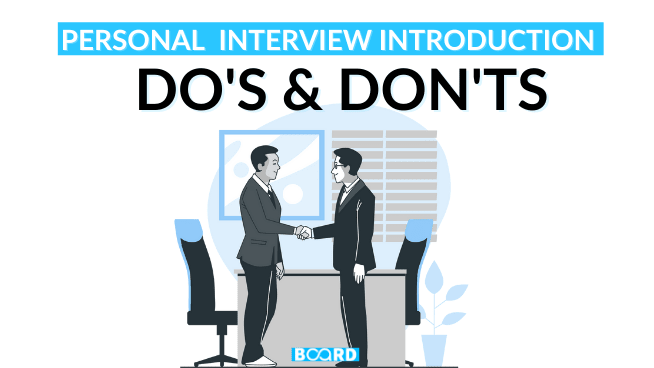
When a candidate faces a Personal Interview (PI), be it on campus for an internship or for final placements or a scholarship or job interview, she/he is asked to ‘introduce herself/himself’. Almost always, this is a standard question with which the interview begins. In this write-up, we will focus on this introduction part of the PI.
The objective of the introduction from the perspective of the interviewer is relatively straight forward. Irrespective of whether the interviewer has read the candidate’s CV or not, the interviewer wants to know a brief summary of the candidate. This is a great opportunity for the candidate, who can achieve the following if the introduction is correctly framed.
- Let the interviewer know what is important about the candidate – Usually, the resume of the candidate is crammed with a lot of information. This gets worse because most B-schools allow a one-page CV for placement interviews and candidates try to use that space ‘optimally’ (read – fit in as much information as possible). Most interviewers do not go through the full CV of the candidate due to lack of time or lack of willingness. In such a situation, the introduction provides a much-needed summary of the candidate’s profile, strengths, and skills. Remember, an interviewer is trying to find a reason to select you. You can make her/his job easier through an effective introduction.
- Usually, a lot of initial questions emanate from the introduction. Given the fresh recall of the introduction, many interviewers start questions which have links to the introduction. This gives the candidate a chance to channelize the starting questions of the interview. In general, when the initial questions are addressed well it serves as a confidence booster for the candidate.
- Creating a good first impression – The introduction is the first communication between the candidate and the interviewer. Like with any human being, the interviewer’s attention span is at its best during the first two to three minutes. When the introduction is uniquely structured, giving out all the highlights of a candidate’s journey including his strengths and skills, it creates a good first impression on the interviewer. It's not for no reason that ‘the first impression is the last impression’ became a popular adage.
Following are some of the do’s and don’ts of a good introduction
- Do not begin the introduction with the most obvious details – ‘My name is XYZ’, ‘I am a second-year Finance student in [MBA college name]’, ‘I am XX years old’. Most unimaginative, it can put a most active brain to sleep.
- Over the ~2 minutes introduction, you should give out two to three strengths of your personality, backed by the instances or time in your life when you demonstrated it.
- Depending on whether the interview is an HR interview or a technical one or a combination of both, the introduction should be a balance of ‘who you are (your strengths, areas of development, life experiences, value system)’ and ‘what you know (your work-ex, your skills, work expertise)’
- You don’t necessarily need to follow the chronology of your life in the introduction. It does not need to specify your school, then college, then work-ex in that order. The order should be driven by how important a specific detail is for the interviewer to know, which skill or strength does it give out.
Keep the following pointers in mind while delivering the introduction. These are equally valuable throughout the interview. However, since the candidate hasn’t built any positive rapport or comfort with the interviewer/the interview, she needs to be mindful of these points as the pre-interview anxiety can easily seep into the introduction. In such a case, a well-poised, confident and yet ‘at-ease’ introduction creates a good impression and vibe.
. Between the time you take your place for the interview and you start speaking, breathe deep (inhale and exhale full range) at least two-three times. This is particularly difficult to follow, given how preoccupied and anxious your mind is in those moments. But this quick exercise will give you the much-needed calmness, stability, and perspective.
· At the cost of sounding like your school PT teacher - Keep the posture straight, shoulders straight, chin up, and keep a pleasant face.
· If possible, maintain eye contact with the interviewers most of the time. Direct eye contact is a great non-verbal way of displaying confidence. It's natural to have eye contact wavered, especially when you are thinking ‘on-the-go’ as you speak. The two places you should never see are the ceiling and the floor.
· Whereas it is important to rehearse the introduction so that you don’t miss an important part of it – It is equally important not to say it in a rehearsed manner. Be natural & take pauses when you deliver the introduction.
· Make sure the tone/pitch and volume of your voice is pleasant and in line with that of the interviewer. Many candidates start speaking in high pitch and/or high volume which gets inconsistent with the overall voice levels in the conversation. This can irritate the interviewer.
Written by - Coach Abhijit Deshmukh, His currently working as Senior Vice President & Head - Inorganic Business, Priority Sector Lending at DBS Bank. He has 15+ years of experience in the finance sector. Over and above he is passionate about coaching, aspirants say insights given by him are actionable and clear-sighted.
If you're stuck in your career, need personalized help with your resume, interview preparation, sector clarity visit us here.
If you want to crack your dream job interview, check out the Board Infinity's completely free Interview preparation course, which gives you 15 hours of power-packed material to help you get ready for your Placements (or change in career path). It will help you build the right knowledge, skills, and attitude for being a step ahead in the selection process and ensure that you are corporate ready!
